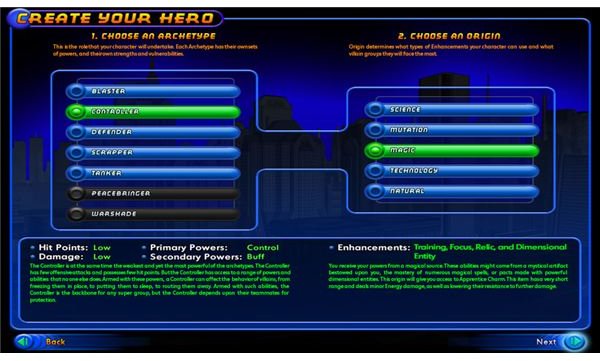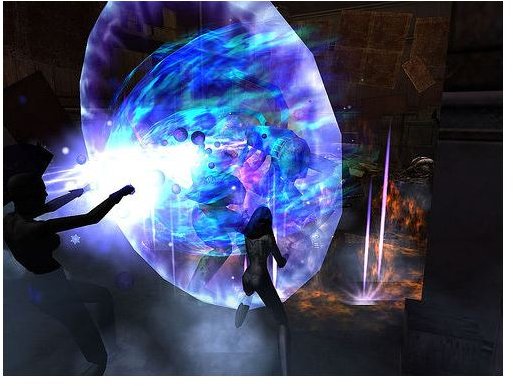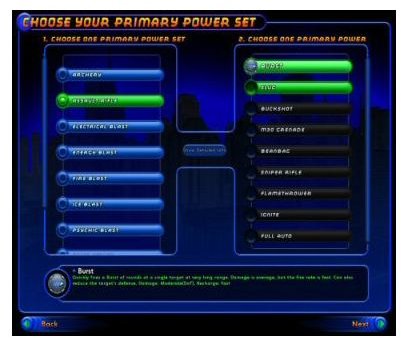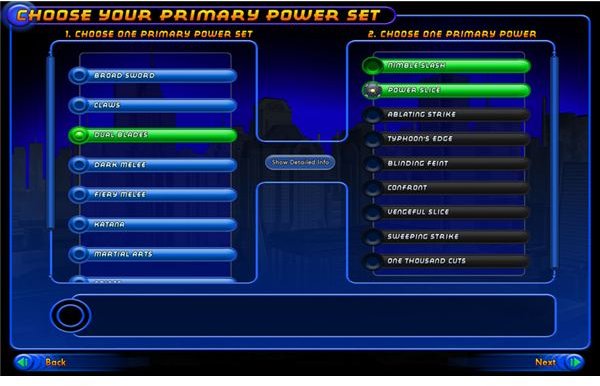An Introduction to the 'Archetype' for first time City of Heroes and City of Villains players.

Benajmin Sell’s guide to character creation highlights the pre issue-16 order of the character creator. In issue 16 you are given the option to jump to whatever step you like until you are satisfied with your character. My guide will expand and explain some of the specifics of, potentially, the most important decision you will make while creating your character: the Archetype. There are five basic Archetypes (or ATs for short) on each side of the game, hero and villain, as well as two Hero Epic Archetypes and two Villain Epic Archetypes. These last four ATs will be grayed out at the bottom of the list for new players and players without at least one maximum level hero and/or villain character.
Okay, So You’ve Clicked the “Create Character” Button. What Next?
The rule of thumb is that new players should begin their heroics with either the Blaster Archetype or the Scrapper AT. For villains the suggestion has been that a first time player should begin with the Corruptor or Stalker Brute ATs. The City of Heroes developers have suggested the Stalker in the past. My feelings are that the Brute is easier to understand. For many people these are the most straightforward types of characters to play, they are mostly expected to damage the enemy as quickly as possible without too much direct concern for the well being of their allies (though ignoring them outright is also frowned on). Controllers, Defenders, Tankers, Dominators, and Masterminds are more specialized and are harder to pick up easily, though that task is certainly not impossible.
But How Should You Decide?
I’ve found that a good starting point to help people better choose their characters is through the conceptual. Especially with City of Heroes, where there is so much customization available to you, a general concept of a character might be useful. Do they have some sort of elemental control, like maybe fire or ice? Do they use a weapon or not? Can they take a lot of damage and stay on their feet? You could even give them a bit of an off-duty personality. Having a general character concept when you start might better help you figure out what exactly he or she does to fight or cause crime. The role a character plays is also important, but for the most part the following characters’ roles are similar enough to not matter significantly.
Ultimately, there are no wrong decisions and if you find that you don’t like the character you’ve created there is nothing stopping you from starting another one. For first time players I highly suggest playing your first character through to level 5, or even level 10. It doesn’t take that long to reach these milestones and keeping with your first character will give you a better sense of the game and how to play it. Generally I’ve found that when a player reaches level 10 for the first time they’ve got all the building blocks necessary to expand into the more difficult ATs.
Continue onto the next page to get a better idea of the Blaster Archetype and the sets you’ll be able to choose from.
If you are unfamiliar with some of the terms I use, why don’t you check out the MMO gaming dictionary.
The Blaster

The Blaster Archetype is the master of ranged attacks and has some of the greatest damage potential for the entire game. To counteract this high ranged damage they are also low on hit points and have limited options when it comes to defense. As a secondary they gain a selection of support related power sets. These sets largely augment the Blaster’s already impressive offensive capabilities though they can also allow for personal buffs, can debuff the enemy, and even allow for some minor controls. These two sets, when combined, allow for a wide variety of game play that is straightforward and easy to pick up for first time players.
The Blaster Inherent
Every Archetype has an inherent ability. These powers further augment the player’s capacity to fulfill their specific role, and are given to each character as soon as they start patrolling Paragon City or the Rouge Isles. The Blaster’s inherent skill is called ‘Defiance’ and reflects the Blaster’s ability to reach deep within themselves to overcome great odds. Defiance is defined by how quickly a blaster, well, blasts. Each attack that successfully hits the target increases the amount of damage the Blaster subsequently deals, for a limited period of time. Additionally, a Blaster is so skilled at using their beginning powers that they can effectively attack their enemy even while held or otherwise incapacitated (excluding knockback effects).
So Which Sets Can You Choose From?
There are hundreds of theories regarding the abilities of each set, which ones are considered better or worse, and so forth. For this guide I’ll be avoiding those discussions. After all, the point of this article isn’t to have the ‘best’ character, but rather to have fun playing the character you choose. So below is a list of the sets available to the Blaster.

Blaster Primary sets
- Archery
- Assault Rifle
- Electrical Blast
- Energy Blast
- Fire Blast
- Ice Blast
- Psychic Blast
- Sonic Blast
Coming with issue 16
- Radiation Blast
Blaster Secondary sets
- Electricity Manipulation
- Energy Manipulation
- Fire Manipulation
- Devices
- Uses a variety of gadgest to keep the enemy occupied.
- Ice Manipulation
- Mental Manipulation
That’s Great, But How do I Choose?!
Blasters are very straightforward, if a bit low on hit points. There isn’t really any difference between each set for the beginning player, just make sure you read the description of any new power before you start using it regularly. If possible, hunt a few bad guys on the street before taking on a mission just to see your new skill in action. So, if your role isn’t going to change based on your primary and secondary sets go ahead and make that concept character you’ve been thinking about. Again, there are no wrong decisions when making a character, it’s about having fun playing the game.
The Scrapper

The Scrapper is known for its upfront damage that, at times, rivals the Blaster’s. Mainly a melee set, you’ll get up close and personal with your enemies before they are defeated. Because the Scrapper favors close fights over ranged ones their secondary set is all about defense. Though generally not as powerful as the Blaster this added defense gives the Scrapper the edge it needs to become the most efficient solo Archetype available to heroes. This isn’t to say they aren’t useful in groups, but if you are a player who likes to work alone the Scrapper might be a better fit.
The Scrapper Inherent
The Scrapper’s inherent power, Critical Hit, is fairly straightforward. For every successful melee attack there is a chance that the hit will land for double the damage. Like the Blaster’s inherent, Critical Hit further augments the Scrapper’s strength, damaging the enemy quickly.
So Which Sets Can You Choose From?

Before I list the sets available to the Scrapper I feel it necessary to expand on the types of defenses available in City of Heroes. These shields can be separated into three general categories: Damage Resistance, Defense, and Mitigation. Damage Resistance references a power’s ability to lower the amount of damage an attack deals, Defense lowers the chance an attack will hit, and Mitigation can mean a variety of things including the capacity to heal one’s wounds as well as the ability to prevent the enemy from attacking in some fashion. Most sets primarily rely on one of these types of skills, though they all have secondary defenses that further ensure survivability.
Scrapper Primary sets
- Broad Sword
- Claws
- Dark Melee
- Dual Blades
- Firey Melee
- Katana
- Martial Arts
- Spines
- Large spines protrude from your chracters body the can be used to attack your enemies.
Coming with Issue 16
- Electric Melee
Scrapper Secondary sets
- Dark Armor
- A Damage Resistance set that has some potent Mitigation and minor Defense.
- Firey Aura
- A Damage Resistance set that offers a boosted damage potential alongside some Mitigation.
- Invulnerability
- A Resistance set that also has some decent Defense with one Mitigation power.
- Regeneration
- A Mitigation set with self heals, increased health regeneration, and some basic Resistance.
- Shield Defense
- Mainly a defensive set, it also includes some minor Damage Resistance and Mitigation.
- Can not be used with the following primary sets: Claws, Dual Blades, Katana, and Spines.
- Super Reflexes
- A Defensive set with some Damage Resistance as you lose health.
- Willpower
- A mixed bag set that doesn’t excel in any one style of defense, but is still strong overall.
Coming with Issue 16
- Electric Armor
- Almost entirely a Damage Resistance set with a minor Mitigation power.
That’s Great, But How do I Choose?!
Like Blasters, Scrappers are pretty straightforward when it comes to beginning game play. They damage the enemy as quickly as possible, with a slightly higher survival rate. You’ll find that close combat can be a little bit more frustrating at times, though certainly not unbearable. Also like the Blaster, the primary sets available to Scrappers are mostly the same for new players. The differences that do exist are minimal. The secondary sets, however, differ enough that you’re going to have to choose which style of defense you want: Damage Resistance, Defense, or Mitigation. None are considered excessively more powerful than the others, but it is something to keep in mind while creating and playing your hero.

Next time I will introduce the beginner villain Archetypes: the Brute, the Stalker, and the Corruptor.
This post is part of the series: City of Heroes/Villains: Choosing your First Archetype Part 1
A closer look at the City of Heroes Archetypes for beginners. Part one covers the hero ATs, the Blaster and Scrapper, and gives some general hints to help you get started on creating your first member of Paragon City.
